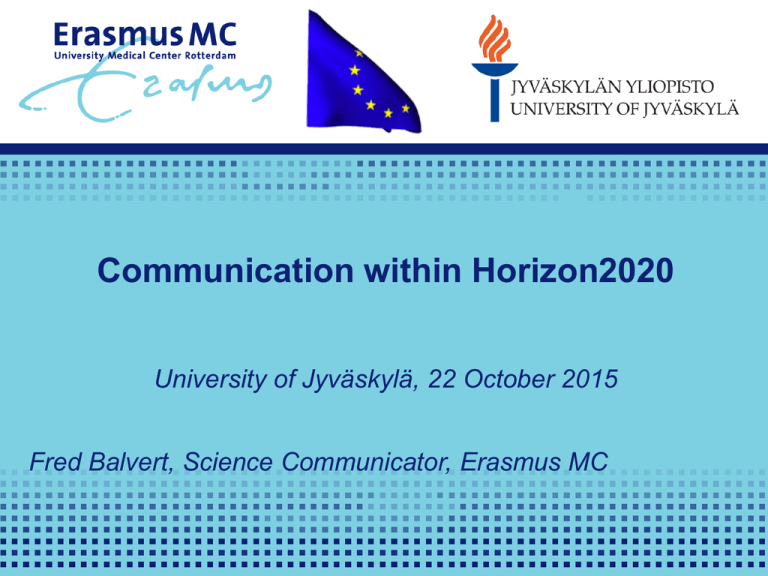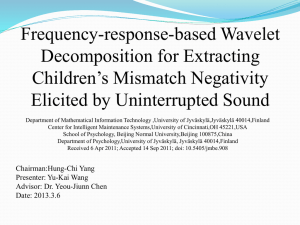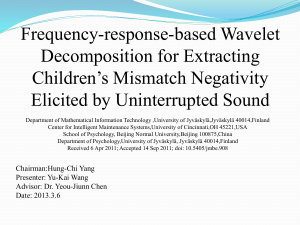Science communication for the general public
advertisement

Communication within Horizon2020 University of Jyväskylä, 22 October 2015 Fred Balvert, Science Communicator, Erasmus MC Communication within Horizon2020 Contents: Responsible Research and Innovation (RRI) Communication at the level of: Work Programmes Work Programme ‘Science with and for Society’ Research projects Practical exercises University of Jyväskylä, 22 October, 2015 Horizon2020 RESPONSIBLE RESEARCH & INNOVATION Science Excellent science • Engage society in agenda setting & design • Gender equality in research process and content Industrial leadership Societal challenges • Science education: new generations • Ethics: societal consequences Society • Open Access: sharing results University of Jyväskylä, 22 October, 2015 Horizon 2020 Public engagement in science Science communication, education and outreach Work programme level: special calls within work programmes Work programme ‘Science with and for Society’ (SwafS) Research project level University of Jyväskylä, 22 October, 2015 Special calls in work programmes MSCA-NIGHT-2016: European Researchers' Night SC1-HCO-12–2016: Digital health literacy EE-06-2016-2017: Engaging private consumers towards sustainable energy ICT-24-2016: Gaming and gamification University of Jyväskylä, 22 October, 2015 Dedicated Work Programme ‘Science with and for Society’ (SwafS) Calls: Science with and for Society Embedding Responsible Research and Innovation in Horizon2020 Research & Innovation Strengthening the Science with and for Society Knowledge-Base Developing Inclusive, Anticipatory Governance for Research & Innovation Other: Euroscience Open Forum University of Jyväskylä, 22 October, 2015 Science with and for Society Examples of calls: SwafS-01-2016: Participatory research and innovation via Science Shops SwafS-11-2017: Science education outside the classroom University of Jyväskylä, 22 October, 2015 Communication in research projects Horizon2020 – Grant Agreement: Art.38 PROMOTING THE ACTION – VISIBILITY OF EU FUNDING “The beneficiaries must promote the action and its results, by providing targeted information to multiple audiences (including the media and the public) in a strategic and effective manner.” University of Jyväskylä, 22 October, 2015 Obligation for research projects Define a ‘comprehensive communication plan’ Include in the proposal a Work Package for communication or include it into another WP Address the ‘public policy perspective’ with their communication activities. Keep communication measures proportionate to the scale of the action. Free to choose the type of communication activities. University of Jyväskylä, 22 October, 2015 Good communication – according to the EC Starts at the outset of the action Continues throughout the entire life cycle Is strategically planned Identifies and sets clear communication objectives Is targeted and adapted to audiences beyond the project’s own community Chooses pertinent messages Uses the right medium and means Is proportionate to the scale of the action University of Jyväskylä, 22 October, 2015 Communicating EU Research & Innovation – A guide for participants http://ec.europa.eu/research/participants/data/ref/h2020/other/gm/h2020-guide-comm_en.pdf University of Jyväskylä, 22 October, 2015 Communication in the project life cycle Proposal Work Package for communication (or in other WP) Comprehensive communication plan Evaluation Taken into consideration as part of the criterion ‘impact’ Reporting Overview of progress must also describe the communication activities Project management EC interim and final assesment Beneficiaries need to inform EC (project officer) prior to communication activity with a major media impact Key elements of slides 12-16 Work Package Communication (or part of other WP) Comprehensive communication plan Start and continue during the project Strategic Promote the action and its results Public policy perspective (which makes it different than dissemination) Communication objectives Targeted information Pertinent messages Multiple audiences beyond the project’s own community Free in choice of communication activities Right medium and means Proportionate University of Jyväskylä, 22 October, 2015 WP Communication plan Core message: follows directly from the action (research project) and its results (mission) What problem does the project solve? Communication strategy: which objectives by which means at which moment Audiences: to whom (beyond the project’s own community) is this relevant Messages: information targeted to these audiences Communication means: chosen to effectively deliver the messages University of Jyväskylä, 22 October, 2015 Example project: ADVANCE (IMI) Core message: Monitoring beneficial and side effects of vaccination on a European scale will further improve effectivity and safety. Audiences: general public, policy makers, school pupils, parents, elderly Messages: School pupils: vaccination is a succesful health intervention, many infectious diseases are prevented Parents: safety is continously monitored Policymakers: results of ADVANCE are available Communication means: press release, leaflet, website, social media, video, informative meetings, science cafés, school lessons, science festivals. Strategy: planning a feasible and effective use of communication means. University of Jyväskylä, 22 October, 2015 Communication matrix • Core message is leading • Every X is a deliberate communication action • Consisting of a message and a means University of Jyväskylä, 22 October, 2015 I am a scientist. I don’t have time for this! Who is going to do it for me? Use existing formats (these have proved to be working) Use existing series and platforms for audiences and promotion (European Researchers’ Night, Science café’s) Ask the Communication Dept. of your institute for advice and support And/or hire an external communication advisor or agency But first ask around for references To participate in Science with and for Society calls connect with network (Ecsite, EUSEA, etc.) Be aware of opportunists! (generic communication business models) University of Jyväskylä, 22 October, 2015 But, don’t forget European citizens think scientists are the ones who should communicate about science (EUROBAROMETER). Communicators provide the stage, it is your show. It is fun! It opens your eyes for questions concerning your research from other perspectives. This is helpful for grant writing, media contacts and societal understanding. University of Jyväskylä, 22 October, 2015 Exercise 1 Defining a core message 1. Work in couples 2. Select an imaginary research topic from the Nano World Map 3. Define a core message for outreach University of Jyväskylä, 22 October, 2015 Exercise 2 Defining target audiences For which audiences could this topic be relevant … and why? University of Jyväskylä, 22 October, 2015 Exercise 3 Defining messages Define a message directed to a specific target audience University of Jyväskylä, 22 October, 2015 Exercise 4 Developing communication means 1. Use one of your messages and target audiences 2. Develop a communication action University of Jyväskylä, 22 October, 2015 Thank you for participating! ‘Prepare for 15 seconds of fame Media contacts for researchers’ Available on www.bol.com Free download on facebook: 15secondsoffame f.balvert@erasmusmc.nl University of Jyväskylä, 22 October, 2015

